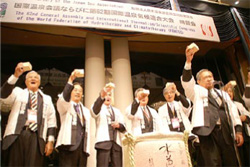Home > Highlighting JAPAN > Highlighting Japan JANUARY 2011 > Attracting MICE with Japanese Treats
Highlighting JAPAN
COVER STORY: The Spirit of Hospitality
Attracting MICE with Japanese Treats
Japan has redoubled its efforts to attract more international meetings and trade fairs to its advanced conference facilities. Miho Kawasaki reports.

Delegates at the 2009 FEMTEC conference in Yokohama enjoy a Japanese-style reception.
Credit: COURTESY OF JAPAN SPA ASSOCIATION
MICE promotion does more than just enable people of various countries to meet and deepen friendly ties with colleagues from other nations in the same industry or fields of expertise. Benefits for the sponsoring locale include boosting economic activity by increasing demand for the services of hotels and local food service businesses, for example. In addition, such events raise international awareness among local residents.
Major international conferences held in Japan since 1979 include five summit conferences of industrialized nations, as well as the third Conference of the Parties to the International Convention on Climate Change (COP 3), which adopted the Kyoto Protocol. Most recently, COP 10 was held in the city of Nagoya, Aichi Prefecture, and the Asia-Pacific Economic Cooperation (APEC) conferences were held in Yokohama last November.
In addition to such international meetings, which draw a lot of media attention, many other MICE events are held in Japan each year.
According to data from the Union of International Associations (UIA), Japan ranked twelfth in the number of such international conferences held worldwide in 2003 and ranked fifth worldwide in 2009 (with 538), second in Asia only to Singapore.
Yuichi Takehara, director for International Tourism Relations at the Japan Tourism Agency (JTA), observes that "Japan's strengths include its internationally unrivalled safety, its extensive transportation network, and the sophisticated level of facilities available for conferences. In addition to the amenities offered at the actual venue where conferences are held, we're trying to highlight the historical background and culture of the locale. Visitors from overseas seem very pleased with the diversity of cuisine available near the venue as well as the polite service they receive at local businesses."
In March of 2010, the JTA conducted a study focusing on people involved in the MICE field in various countries and found that 76.5% gave Japan a MICE rating of "high" or "fairly high." With regard to Japan's attractiveness as a venue, 64.7% rated Japan's cultural sites as "rich" and 58.8% rated the quality of services available as "high."
Hot Spring Hospitality
One example of the unique kinds of international conferences held in Japan was the meeting of the International Thermalism/Scientific Congress of the World Federation of Hydro雜ウtherapy and Climatotherapy (FEMTEC) held over five days in November of 2009 in Kanagawa Prefecture, and hosted by the Japan Spa Association (JSA). Attending the conference were about 300 participants from twelve countries in Europe, Asia and elsewhere. They included hot spring business operators, balneological and geological researchers and other hot spring experts. Following various speeches and scholarly presentations in Yokohama on hot spring conditions in various countries, the conference shifted to a venue in Hakone, a hot spring region within the prefecture, where a ceremony was held. After the completion of the conference agenda, an optional inspection tour of Kusatsu Hot Spring in Gunma Prefecture was organized.
JSA Senior Managing Director Toru Terada says he believed that JSA members and local people were able to provide truly genuine hospitality.
"Partly because the city of Yokohama is accustomed to hosting international conferences," explains Terada, "local people lent participants considerable help in various ways, including giving them directions. At the presentation in Hakone, attendees wore yukata robes, which are often worn at Japanese hot spring resorts. They were also able to try Kusatsu's famous yumomi style of bathing. The temperature of the hot spring water at the Kusatsu spa often exceeds 50螻曚. Yumomi is the way to cool down the temperature of hot spring water without adding cool water, by stirring with long wooden paddles. I think it must have been a good chance for participants to learn about Japanese hot springs."
Mixing with the Locals
Meanwhile, the Japanese Urological Association (JUA) succeeded in its bid to host the thirty-second congress of the International Society of Urology (ISU) in September of 2011 in the city of Fukuoka.
One JUA member working on JUA's effort to attract the conference recalls that "when prominent members of the ISU with a lot of influence in the venue decision visited Fukuoka, they were apparently quite taken by the lively atmosphere of the local Nakasukawabata shopping district and suggested it might be a good place for an evening event, or a party with about 2,500 guests. I had thought of showing them newer places of interest such as Fukuoka Dome, but I realized that people from overseas are interested in things Japanese, which they can't see in their own country. They're looking for places where they can mix with the local people. Our desire to convey the attractions of our locale therefore fit perfectly with the sponsor's wish to interact with locals, and that became the deciding factor in our successful bid."
© 2009 Cabinet Office, Government of Japan






